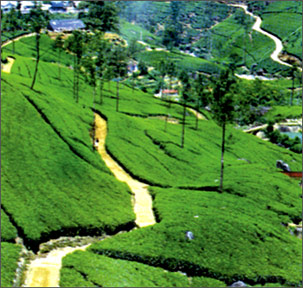Challenges in marketing Sri Lankan tea
Sri Lanka’s Tea industry a year ago was recovering, buoyed by
production and earnings estimates of 310 m kg and US $ 1.5 b until
trouble hit prompting a US$150m Government bailout.
|

MTI Consulting Director, Suraj Deen |
Thus Sri Lanka’s tea price movements behave like any other commodity,
responding to pipeline demand systems. Last year, tea prices soared on a
general upswing in commodity prices. Tea production on the other hand
was up due to the improved rainfall and fewer labour disruptions.
Therefore the recent industry bucking trend is not fully attributable to
production and marketing initiatives, but purely to external market
forces. MTI’s research and analytics point to deep rooted strategic
challenges facing the tea industry that subsidies may not address. We
also comment broadly on initiatives that the industry should reflect on
in the context of today’s hard times.
Kenya tea
The fact is that Kenya, our closest rival produces far more tea per
hectare than Sri Lanka and that her labour productivity is nearly double
than ours. Kenya’s labour costs are only 43% of production costs
compared to Sri Lanka’s 60%; certainly a cause for concern. Producers
point to these statistics and other input costs to justify their demand
for subsidies.
To meet global price benchmarks, therefore firms often focus on
visible productivity measures such as Kg per labour-day without
considering factors that may have an impact on the quantity (Kg) of Tea
plucked. Studies by the ILO and others indicate that plants per hectare,
the height, weight, age and experience of the plucker etc contribute to
labour productivity. Unfortunately many companies put undue focus on
input cost reduction.
Though popular, this method looks inward and ignores revenue
optimization, because while managers keep their eye on the inputs radar,
output never gets measured. Contrast this with the revenue optimization
model which on the other hand seeks holistic and creative ways to
increase revenue with the limited resources at the producers’ disposal.
 While the internet will bring buyers and sellers closer in a
“buyer-seller market space” the traditional auction system will continue
to play a significant role in the foreseeable future. However Sri Lankan
companies will do well to realize that it is not the endpoint of the
value chain and that producers need to play an active role beyond the
auctions. Multinational Companies (MNCs) understand this and are
minimizing the dependence on the auction system by integrating their
supply chain and control of front end channels as shown below. While the internet will bring buyers and sellers closer in a
“buyer-seller market space” the traditional auction system will continue
to play a significant role in the foreseeable future. However Sri Lankan
companies will do well to realize that it is not the endpoint of the
value chain and that producers need to play an active role beyond the
auctions. Multinational Companies (MNCs) understand this and are
minimizing the dependence on the auction system by integrating their
supply chain and control of front end channels as shown below.
Future markets
Future markets may not be secure as MNC’s seek to fully control and
integrate their supply chains. Unilever owns a large number of estates
particularly in Africa. Tata having secured supplies off their own
estates is taking control of the front end marketing channels. These are
strategic choices albeit one on the supply side and the other on the
demand side. Local producers will become increasingly vulnerable as
these giants look within for their supplies and others shift their
sourcing to more productive and cost effective tea producing regions
such as the ACP countries.
The total market for tea is approximately US $ 47 b. of which we have
significant share in declining markets such Europe and ME. Despite Sri
Lanka being the largest single exporter of tea we do not enjoy a
corresponding revenue share. Another is that we are not present in big
revenue markets. Though the US per capita tea consumption is low, it is
the biggest revenue market, paying top dollar per cup. It is the most
innovative market as well. Yet Sri Lankan tea has little or no presence
there, being content to dominate traditional markets in Europe, the CIS
and the Middle East.
Tata is making significant gains in the US and European markets
through strategic acquisitions. The acquisition of Tetley gave Tata
instant access to the British and European markets. ‘Honest Tea’, a fast
growing organic brand by aligning with Coca-Cola gained access to coke’s
huge distribution network. Sri Lankan producers however at their own
peril see no role beyond the value chain.
MNC branding strategies support this contention. Unilever controls
nearly 15% of the global market with an array of brands led by Lipton.
These brands have transcended national and regional boundaries, and may
not necessarily use country of origin as a key driver of their brand
strategy.
Repositioning traditional teas will also take place parallel to ready
to drink (RTDs) teas. Unilever re-launched Lipton changing its image
from a “grey” brand to “rainbow of colours” creating universal appeal.
Further an exciting new tea brand “Teavanah” with an array of products
that have an elitist appeal, is creating new market space in the
upper-end US fashion malls. New innovations are being rolled out as top
quality teas are made available in Pyramid tea bags, easy to use
nylon-mesh and other plungers that make brewing tea fun.
Carbon footprint
Today more and more consumers worry about their consumption choices.
What is your carbon foot print? Is the product procured by fair means?
Is it ethical? Thus issue based choices are becoming the norm. While
this trend is new and the impact small, these are emerging trends that
MNCs such as Coca-Cola, Unilever and Starbucks have already embraced.
Sustainability is one of the key brand values of Starbucks. Unilever
is fully committed to sustainable tea and coffee. Environmental
stewardship allows the company to command a premium, post its Rainforest
Alliance certification. Similarly fair-trade certification is becoming
important. While ISO, HACCP and GMP are mandated by most importing
countries to ensure traceability, Fair-trade and Sustainable Tea are
voluntary positions taken by companies to appeal to consumers. As noted
elsewhere, while the global market has made major strategic shifts, Sri
Lanka lags behind. There are some key strategic options that Sri Lanka
needs to be mindful if we are to remain competitive.
This position can only change if strategic marketing plays a key
role. Because Sri Lanka is not competitive both at country and firm
levels it will remain a price taker. Competing countries such as India
and China, who may become net exporters together with other countries
emerging as exporters, will continue to push prices down. As a producing
country competing in a market where supply exceeds demand, Sri Lanka
will end up being a price taker. At the firm level, Sri Lankan companies
compete with established brand marketers such as Unilever and Tata.
Since it is unlikely that Sri Lanka can build ‘larger than life’ brands
similar to Lipton, and Nestea, we will be compelled to compete at a
non-brand level in the foreseeable future. Some of the long term
strategic initiatives the industry has neglected must be resolved
speedily. Admittedly, we have the expertise, but not the will to make
the hard decisions. Not enforcing the “4% of total acreage under
replanting” norm is one such example that affects us on two fronts. One,
inadequate replanting prevents the introduction of better yielding
varieties of tea. On the other front, aging plants negatively impact the
yield and quality of tea.
We cannot escape resolving the intractable issues of plantation
worker management and the reluctance to adopt time tested HR practices
must be overcome. The building blocks of good HR if implemented properly
would benefit the industry as a whole. The old mindset must give way to
empowering the worker, giving them choices, and involving them in the
decisions that affect them. Further they must be groomed to take up
positions beyond the “labour category” and lead hopefully to fewer
disruptions.
Plantations should embrace international sustainability and
compliance challenges including, forestry, and eco-system management. A
pragmatic approach to balancing the need to create short term cash
crops, animal husbandry etc must be given serious thought. This should
lead to creating alternative employment opportunities. These are areas
that may not be core. However business models are available that support
such activity.
Consolidation and integration of both on-line and off-line channels
etc will make competing against branded products increasingly difficult.
Producers must take control and play an active role along the value
chain. Many growers co-operate to form marketing entities that take on
responsibility for marketing their produce. Successful models can be
found across the globe and take various forms from co-operatives to PLCs.
Fonterra, is a good example of a co-operative of dairy producers
evolving into an international brand marketing giant. |





